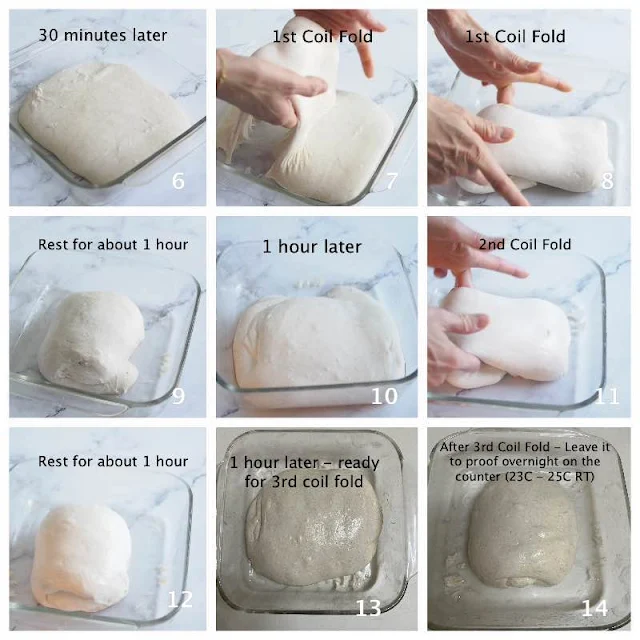Breads (Sourdough) - Open Crumb
Sourdough Fougasse
August 03, 2023
| Recipe by Bake with Paws
Scroll to the bottom of the page for "PRINT RECIPE" ⬇
I have wanted to bake a Sourdough Fougasse for sometimes now and when I saw the rustic Sourdough Fougasse from @Breadstaker I was especially inspired to attempt this bake. I love the rustic and plumped up Fougasse. It is not so difficult to bake and it is quite similar to my Sourdough Ciabatta Recipe except I left it to proof on the counter overnight instead of cold retard. This bread is crusty and so satisfying to break apart and eat with butter, especially fresh out of the oven.
If you have any questions regarding this recipe or any other post, please leave me a comment in the “LEAVE A COMMENT” link and I will reply you as soon as possible. Do tag me on Instagram @Bakewithpaws if you attempt on this recipe.
How To Make Sourdough Fougasse
Yields: 2
INGREDIENTS:
60g active sourdough starter (100% hydration) - 20%
270g bread flour (I used Japanese high gluten flour) - 90%
30g whole wheat flour - 10%
234g water - 80%
6g sea salt
10g olive oil
Room temperature: 24C - 25C
METHOD:
- Levain : (Around 5 pm)
- Feed ratio of 1:1:1, keep at room temperature (28C – 30C) and wait until tripled, around 3 – 4 hours. Please feed your starter at the ratio that fit your schedule as long as the starter is at its peak when use.
- Mix the dough : (9 pm)
- Dissolve levain and water in a bowl of stand mixer. Add in olive oil, salt and flour. Mix with paddle attachment for about 3 - 4 minutes at speed 2 (KA mixer) and slowly turn to speed 4 or until the dough turns smooth, comes together and away from the sides of the bowl. Transfer the dough into a greased bulking dish. Cover and rest for 30 minutes.
- Coild Fold :
- Coild Fold 1 (9.45 pm) – Fold in the dish. Cover and rest for about 1 hour
- Coild Fold 2 (10.45pm) – Repeat the same. Cover and rest for about 1 hour
- Coil Fold 3 (11.45 pm) – Repeat the same. Cover and leave aside to proof at room temperature (24C - 25C) till next morning.
- Shaping: (Next Morning around 9.30 am)
- By this time the dough should have rise almost double the size. Place the dough in the freezer for around 30 - 45 minutes while preheating the oven. This will firm up the dough for easy handling.
- Transfer to a heavy floured counter top. Dust the dough with some flour and cut into 2 equal portions with a scrapper or knife.
- Transfer and flip the dough (smooth side is facing up) to a parchment paper. Repeat the same to another dough.
- Using a sharp knife or scrapper, cut 3 or 4 slits. Gently open up each slit with your fingers by stretching the dough.
- Baking -
- Preheat oven with the dutch oven (cast iron) at 250C (top & bottom heat) for 30 - 60 minutes before baking.
- Transfer the dough with a scrapper to the preheated dutch oven.
- Bake with cover on for 25 minutes.
- Remove bread from oven and dutch oven. Let it cool on rack completely before slicing.
Mixing The Dough
Coil Folds
Shaping and Baking
GENERAL NOTES
SOURDOUGH STARTER
Please click this link for "How To Make Sourdough Starter" and "Sourdough Maintenance"
A healthy starter is very crucial as advised by Baking with Gina. It is advisable to feed your starter regularly if you want your bread to rise nicely and to use the starter (levain) at its peak. A starter that is fed regularly will be more active in general. If the mother starter is not strong, the bread dough will not rise a lot even though the starter is used at its peak.
HYDRATION
The liquid measurement given is also a guide. It is advisable to always reserve some liquid and not add it all in one go. This would give you the opportunity to adjust if necessary. If dough is too dry, add the reserve liquid one tablespoon at a time until the right consistency. This is because each flour absorbs water and hydrates differently.
BULK FERMENTATION
Bulk fermentation starts when you add in levain to the dough and ends when the dough is ready for shaping.
TEMPERATURE DURING BULK FERMENTATION
Ambient temperature plays a very important part in sourdough baking. It will affect the dough temperature and eventually affect your fermentation time. The cooler ambient temperature will extend the fermentation time. The greater degree of proof, the stronger the dough will be as explained by Trevor J. Wilson.
The ambient temperature that worked for me is between 25C - 26C and bulk fermentation time is between 4.5 hours to 5.5 hours. At the end of bulk fermentation, my dough would have increased 50% in volume. The dough should look puffy. It should jiggling when you slightly shake it. This is the end of bulk fermentation.
But, my kitchen ambient temperature (without air-conditioner) was 29C - 30C. So, I have to bring down the temperature.
How to bring down ambient temperature?
- Air-conditioner room - Rest the dough in air-conditioner room during bulk fermentation. I used this option sometimes. I turned on my air-conditioner when I added in levain and try to maintain temperature between 25C - 26C.
- Home oven (that's turned off) - Place ice cooler packs inside along with an ambient temperature thermometer. Then place your dough during bulk fermentation in the oven. Keep an eye on that thermometer and try to keep between 25C - 26C.
DOUGH STRENGTH AND EXTENSIBILITY
Too strong (tension or elastic) dough will take a longer time to increase (proof) in volume. So too strong dough may not have good oven spring and open crumb. While too weak dough (extensibility) dough may not hold it shape and rise with good oven spring too.
So over-working the dough (too strong dough) or under-working (weak dough) may affect the crumb structure and oven spring.
The number of coil folds is not fixed and very much depends on the strength and extensibility of the dough.
As demonstrated in an experiment by Kristen (Full Proof Baking) the over-worked dough rose super tall but was smaller in overall size and had a more dense crumb while the control dough rose tall during the oven spring and had a better overall result.
How do we know when it is enough and no more coil folds are needed?
We usually do 3 coil folds for this method. However, if by the second coil fold the dough is strong with less extensibility as you lift up a part of the dough then it should be the last coil fold, or just do a half coil folds instead of full. The resistance of the dough to being folded should be an indication to refrain from folding further.
How do we know when to do the next coil fold or stretch & fold?
When the dough spreads. Please do not rely on the time given in the recipe as it is just a guideline. Please watch your dough and not the clock.
Labels:
Breads (Sourdough) - Open Crumb,







Comments
Post a Comment